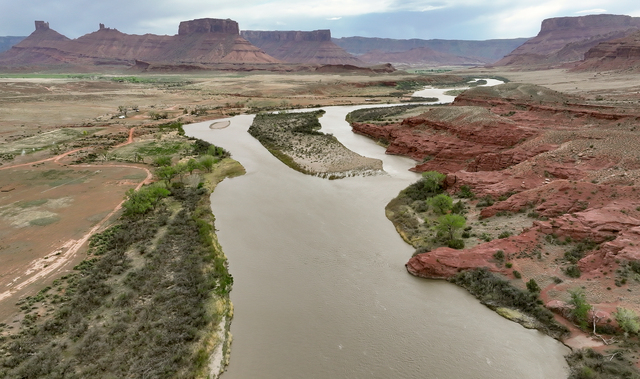The Colorado River Collaborative
Journalists and water experts raft down the Moab Daily section of the Colorado River with Holiday River Expeditions during a kickoff event for the Colorado River Collaborative in Grand County on Thursday, April 25, 2024. (Kristin Murphy, Deseret News)
The lifeblood of the American West is in crisis, due to climate change, drought, growth and overuse.
The Colorado River Collaborative is a group of 12 news and education organizations that launched in April 2024. Our goal is to explain how Utahns are impacted by the river, its tributaries and destinations and what can be done to make a difference. It is an extension of the award-winning Great Salt Lake Collaborative.
The 11 member newsrooms will pool resources for more in-depth coverage of the Colorado River. As a solutions journalism initiative, collaborative stories will also explain what can be done to adapt to the new realities facing the river, what actions are being taken and why.
Who We Are
Colorado River Collaborative members pose for a portrait outside of Utah State University Moab in Grand County on Friday, April 26, 2024. (Kristin Murphy, Deseret News)
The Colorado River Collaborative includes the following media partners (listed alphabetically). While the news partners may have viewed each other in the past as amiable competitors, we believe this issue is too important to cover alone. By working together — creating stories together and sharing what we report individually — we can do better journalism and reach new audiences on a topic with far-reaching implications that is crucial to Utahns’ quality of life.
- FOX 13 News
- KSL-TV
- KSL.com
- KUER
- KZMU Moab Community Radio
- Moab Times-Independent
- PBS Utah
- Radio West
- Salt Lake Tribune
- St. George News
- Utah Public Radio

This expanded reporting scope is made possible due to a founding gift from the Utah State University’s Janet Quinney Lawson Institute for Land, Water, & Air. The Institute is also a collaborative education partner, providing access to USU experts on the river.
All editorial decisions are made independently by member news organizations in accordance with their respective editorial policies. See our full editorial policy below.
Contact us:
Heather May is the Director. You can contact her at
Why We Are Doing This
Water flows through the Colorado River Moab Daily in Grand County on Thursday, April 25, 2024. (Kristin Murphy, Deseret News)
Known as America’s Nile, the Colorado River is in crisis. Climate change has hastened evaporation from reservoirs (including the two largest in the United States, Lake Powell and Lake Mead), melted snowpack earlier and dried out the soil so that it soaks up precipitation before reaching the river. Snowmelt run-off and river flows have dropped 20% compared to the early 20th century, even as the population that relies on the river has exploded. The decline in water storage and river flows puts major cities, large food producers and the environment at risk.
The collaborative’s emphasis will be on exploring the importance of the river and the impacts of its decline on Utahns. Much of the U.S. news coverage about the river focuses on water users in the Lower Basin states — California, Arizona and Nevada. But water from the Colorado River is crucial to the fate of Utah, which grew faster than any other state from 2010 to 2020, and whose population is projected to jump from 3.3 million to 5.5 million in 2060.
According to the Colorado River Authority of Utah, the river is a key source of municipal water for Utah’s most densely populated counties and the rapidly growing southwestern region of the state. The river and its reservoirs fuel a recreation industry that generates $750 million in economic activity. Federally recognized tribes within Utah have claims to the water for agricultural, cultural and economic purposes. Its hydropower dams, including one located in Utah, are a significant source of electricity in the southwestern U.S. and Mexico.
About the Great Salt Lake Collaborative
The groundbreaking Great Salt Lake Collaborative launched in 2022 and since then its dozen local news partners have produced nearly 600 stories about the Great Salt Lake, exploring why it is shrinking, the impacts to public health, ecology and the economy and potential solutions to get more water to the lake.
Its model of sharing stories across newsrooms, focusing on solutions and catalyzing cross-newsroom reporting projects has been nationally recognized for relentlessly focusing on a single urgent issue and locally for spurring Utahns to care about a body of water they once dismissed as a waste.
Our Editorial independence policy
Our organization retains full authority over editorial content to protect the best journalistic and business interests of our organization. We maintain a firewall between news coverage decisions and sources of all revenue. Acceptance of financial support does not constitute implied or actual endorsement of donors or their products, services or opinions.
We accept gifts, grants and sponsorships from individuals and organizations for the general support of our activities, but our news judgments are made independently and not on the basis of donor support.
Our organization may consider donations to support the coverage of particular topics, but our organization maintains editorial control of the coverage. We will cede no right of review or influence of editorial content, nor of unauthorized distribution of editorial content.
Our organization will make public all donors who give a total of $5,000 or more per year. We will accept anonymous donations for general support only if it is clear that sufficient safeguards have been put into place that the expenditure of that donation is made independently by our organization.




